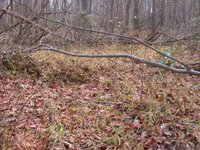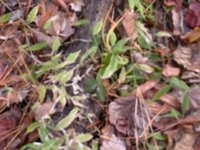 on name for Oplismenus hirtellus subsp undulatifolius. Dr. Marc Imlay and his team of volunteers working to remove invasive species from a park in Maryland near Washington, DC., think they have an excellent case for early detection and rapid response. Today, I walked into the park with Dr. Imlay and say for my self the almost three acres of infested area.
on name for Oplismenus hirtellus subsp undulatifolius. Dr. Marc Imlay and his team of volunteers working to remove invasive species from a park in Maryland near Washington, DC., think they have an excellent case for early detection and rapid response. Today, I walked into the park with Dr. Imlay and say for my self the almost three acres of infested area.Of course I should have walked over the hill to the USDA National Library through the Beltsville Agricultural Research Center, but instead I turned to easy to use if not always trusty web search engines to learn more about this grass. I can see
 the demons of conflicting schools of thought before I even read through the pages of information on line, including the basic claim of native to where, along with the infamous Hedera-helix- spp-are-not-invasive discussion.
the demons of conflicting schools of thought before I even read through the pages of information on line, including the basic claim of native to where, along with the infamous Hedera-helix- spp-are-not-invasive discussion.Dr. Imlay has well planted sources which reported to him that: “Paul Peterson at the Natural History museum identified the grass as Oplismenus hirtellus subsp undulatifolius. He published a note on this grass in 1999 along with Charlie Davis, Ed Uebel and Rob Soreng, when it was found to be a new record for North America. Ed Uebel discovered it in Patapsco Valley State Park, (MD) and another site several miles north of the park, occurring in small to medium sized patches. It is native to southern Europe and southeastern Asia. It certainly sounds like it has the potential to be another invasive since it is stoloniferous, has seeds that stick to clothing, and appeared to be spreading according to Ed Uebel.”
The first site that I found was courtesy of Isabel Johnson, KwaZulu-Natal National Botanical Garden:
“Description This is a creeping or rambling perennial grass, which roots and branches freely from the nodes. The broad, deep green, lancet-shaped leaves are held horizontally and create a woven effect when viewed from above. The flowers, which appear from December to June, are borne on longitudinal racemes branching out from the culm or flowering stalk, which extends about 200 mm above the leaves. The purple awns are sticky, especially when fresh.
Distribution A typical constituent of the forest undergrowth, tolerating dense shade, basket grass is widespread in the eastern regions of southern Africa . It occurs in the summer rainfall areas and is not usually exposed to frost as it grows underneath trees.
Derivation of name and historical aspects This is a small genus of three or four species widespread in the subtropical regions of the world, and related to Panicum grass). O. hirtellus is similar in appearance to O. undulatifolius , which occurs in the same habitat, but the latter has clumped, not longitudinal, spikelets.
Ecology The sticky seeds attach to visiting animals and birds, which carry them to new areas. Most grasses are wind- or self-pollinated, but little is known of the pollination of shade grass.
Uses and cultural aspects This grass is used horticulturally, especially in the USA , where a variegated pink, white and green form is popular in hanging baskets.
Growing Oplismenus hirtellus A good groundcover for difficult shady areas, this grass deserves to be used much more extensively. Basket grass is ideal to plant between stepping-stones along shady paths. It can be lightly mowed, but this is best done infrequently and with the lawnmower at the highest setting. As with all shade grasses, a large leaf area is essential to receive enough light for photosynthesis, so it will not survive if kept short. It will also tolerate some sun, and can be planted in less shady areas. This grass is easy to grow in a mixture of loam, leaf mould, and sand. It may be propagated by runners, or from seed, which is freely produced and germinates readily.”
Astute readers will note the reference to horticultural use above. As a plantsman, I am immediately intrigued. The WeedUS Database lists the species as an invader in Hawaii. Wilcox Nursery in Florida lists the species as native – to Florida – I assume. I must note hear that a check with the staff at my own place of business, Behnke Nurseries, reveals that we did indeed try to sell this plant a few years ago. And this from the park’s neighbors, United States Department of Agriculture, Agricultural Research Service, Beltsville Area, Germplasm Resources Information Network :
Distributional range
AFRICA
Northeast Tropical Africa: Eritrea; Ethiopia, East Tropical Africa: Kenya; Tanzania; Uganda, West-Central Tropical Africa: Cameroon; Equatorial Guinea – Bioko, West Tropical Africa: Cote D'Ivoire; Ghana; Liberia; Mali; Nigeria; Senegal; Sierra Leone; Togo, South Tropical Africa: Malawi; Zambia; Zimbabwe, Southern Africa: Botswana; South Africa - Cape Province [e.], Natal, Transvaal; Swaziland
ASIA-TEMPERATE Arabian Peninsula: Yemen
NORTHERN AMERICA
Southeastern U.S.A.: United States - Alabama, Arkansas, Florida, Georgia, Louisiana, Maryland [n.-c.], Mississippi, North Carolina, South Carolina, South-Central U.S.A.: United States - Texas
PACIFIC
South-Central Pacific: French Polynesia, Southwestern Pacific: Fiji ,
SOUTHERN AMERICA
Mesoamerica: Belize; Costa Rica; El Salvador; Guatemala; Honduras; Nicaragua; Panama, Caribbean: Antigua and Barbuda - Antigua; Bahamas; Cuba; Dominica; Grenada; Guadeloupe; Hispaniola; Jamaica; Martinique; Netherlands Antilles; Puerto Rico; St. Kitts and Nevis - St. Kitts; St. Lucia; St. Vincent and Grenadines, Northern South America: French Guiana; Guyana; Suriname; Venezuela, Brazil: Brazil, Western South America: Bolivia; Colombia; Ecuador; Peru, Southern South America: Argentina; Paraguay; Uruguay
The crux of the matter is that we are at a decision point. We could do nothing and see what happens; or we could eliminate this plant from natural areas and reconsider its propagation and distribution before it becomes a commodity both for homeowners and for land managers. Early detection and rapid response is an attempt to prevent the spread of pests such as the emerald ash borer, also here in my home county of Prince George’s, and northern snakeheads; yes, also in my county. Waiting to see what happens can lead to kudzu and fire ants, too little too late and now, we collectively pay the price for inaction.
2 comments:
Hello,
What was ultimately decided with respect to the wavy-leaved basket grass? Was it eliminated?
I have asked Dr. Imlay to provide an update soon. I have also written several other times on this species: http://ipetrus.blogspot.com/2006/11/new-invader-early-detection-rapid.html
http://ipetrus.blogspot.com/2007/05/invasive-event-early-detection-rapid.html
http://ipetrus.blogspot.com/2007/07/invasive-species-follow-up-basket-grass.html
Dr. Imlay has created a volunteer Basket Grass Local Taskforce and has expanded his search inconjunction with ARS into the neighboring USDA Research Center, as well as into a park two miles east in Greenbelt, Maryland
Post a Comment